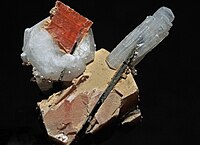
Photo from wikipedia
The quest for enhanced electrocatalysts can be boosted by descriptor-based analyses. Because adsorption energies are the most common descriptors, electrocatalyst design is largely based on brute-force routines that comb materials… Click to show full abstract
The quest for enhanced electrocatalysts can be boosted by descriptor-based analyses. Because adsorption energies are the most common descriptors, electrocatalyst design is largely based on brute-force routines that comb materials databases until an energetic criterion is verified. In this review, it is shown that an alternative is provided by generalized coordination numbers (denoted by CN ¯ $\overline {{\rm{CN}}} $ or GCN), an inexpensive geometric descriptor for strained and unstrained transition metals and some alloys. CN ¯ $\overline {{\rm{CN}}} $ captures trends in adsorption energies on both extended surfaces and nanoparticles and is used to elaborate structure-sensitive electrocatalytic activity plots and selectivity maps. Importantly, CN ¯ $\overline {{\rm{CN}}} $ outlines the geometric configuration of the active sites, thereby enabling an atom-by-atom design, which is not possible using energetic descriptors. Specific examples for various adsorbates (e.g., *OH, *OOH, *CO, and *H), metals (e.g., Pt and Cu), and electrocatalytic reactions (e.g., O2 reduction, H2 evolution, CO oxidation, and reduction) are presented, and comparisons are made against other descriptors.
Journal Title: Advanced science
Year Published: 2023
Link to full text (if available)
Share on Social Media: Sign Up to like & get
recommendations!